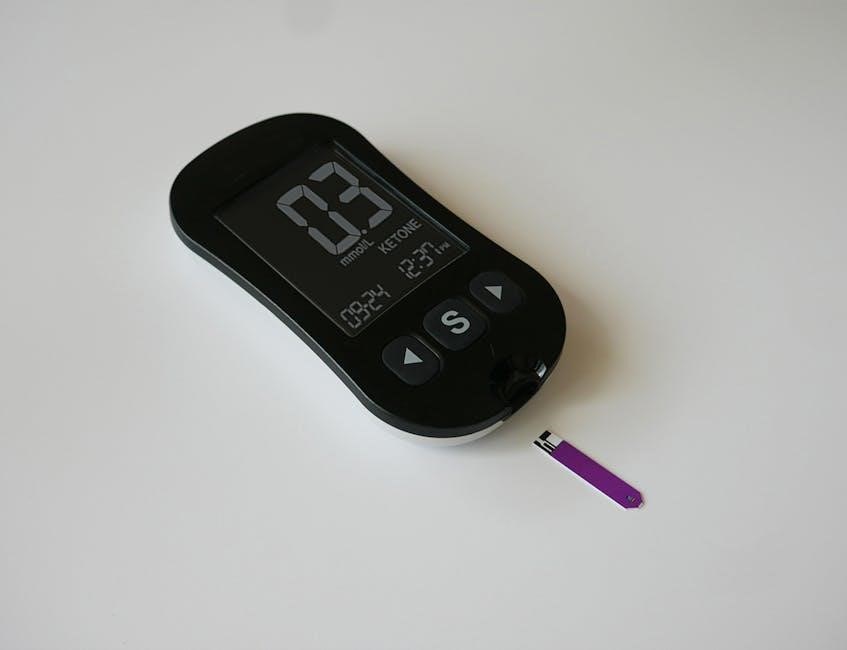Welcome to the BIOS Blood Pressure Monitor guide, designed to help users accurately measure and manage blood pressure․ This comprehensive manual covers setup, calibration, and interpretation of results for effective health monitoring․
Overview of BIOS Blood Pressure Monitor
The BIOS Blood Pressure Monitor is a digital device designed to provide accurate and reliable blood pressure readings․ It features an easy-to-use interface, automatic cuff inflation, and memory storage for multiple users․ The monitor is portable, making it ideal for home or clinical use․ It ensures precise measurements with advanced sensors and is compatible with various cuff sizes to accommodate different arm circumferences․ The device also includes features like pulse rate detection and irregular heartbeat indicators․ With its user-friendly design and robust functionality, the BIOS Blood Pressure Monitor is a valuable tool for monitoring cardiovascular health․ Regular use can help individuals track their blood pressure trends and manage hypertension effectively․ Proper usage and calibration are essential to ensure accurate readings and maintain the device’s longevity․
Importance of Proper Usage
Proper usage of the BIOS Blood Pressure Monitor is crucial for obtaining accurate readings and ensuring user safety․ Incorrect techniques can lead to inaccurate results, potentially causing misdiagnosis or inappropriate treatment decisions․ Following the guidelines ensures reliable data, enabling effective monitoring of blood pressure trends․ Proper cuff placement, correct posture, and avoiding movement during measurement are essential for precise readings․ Additionally, regular calibration and maintenance of the device guarantee its accuracy over time․ Adhering to the instructions also helps prevent device damage, extending its lifespan․ By using the monitor correctly, users can make informed health decisions and maintain better control over their cardiovascular well-being․ Proper usage is the foundation for maximizing the benefits of this essential health monitoring tool․
Structure of the Guide

This guide is organized into clear sections to ensure easy navigation and comprehensive understanding of the BIOS Blood Pressure Monitor․ It begins with an introduction, followed by unpacking and initial setup instructions․ The preparation and measurement processes are detailed to guide users through accurate blood pressure monitoring․ Calibration and accuracy sections emphasize maintaining reliable readings, while data management explains storing and accessing results․ Maintenance and troubleshooting tips help extend the device’s lifespan and resolve common issues․ Finally, the conclusion summarizes key points and provides final tips for effective use․ This structured approach ensures users can confidently operate and maintain their BIOS Blood Pressure Monitor, making it an essential resource for optimal health monitoring․
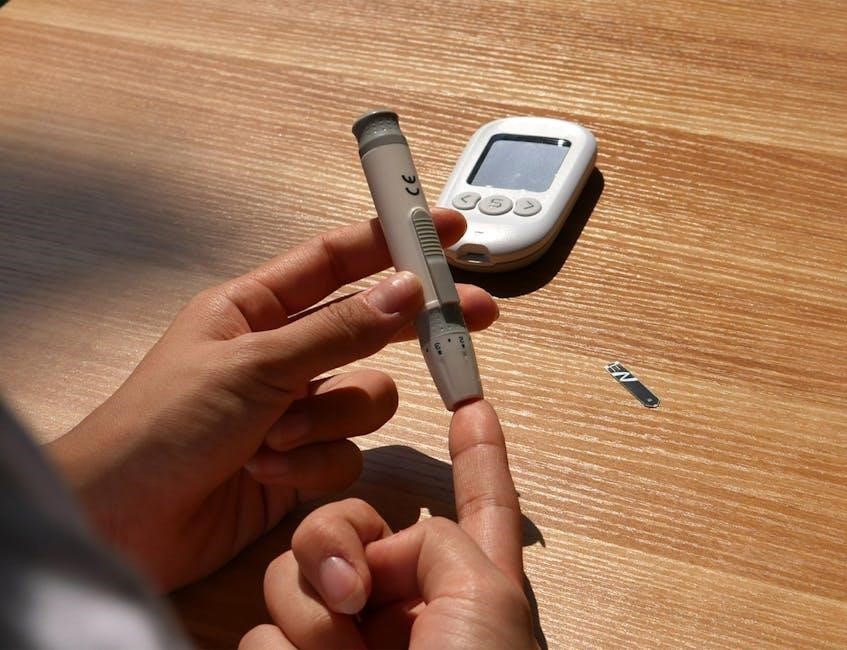
Unpacking and Initial Setup
Unpack the BIOS Blood Pressure Monitor, ensuring all components are included․ Carefully connect the device to a power source and place it on a stable surface․
Contents of the Package
Your BIOS Blood Pressure Monitor package includes the main monitoring device, a blood pressure cuff, a power adapter, a set of batteries, a user manual, and a storage pouch․ The device is designed for easy setup and use, with the cuff specifically crafted for accurate readings․ The power adapter ensures reliable operation, while the batteries provide convenience for portable use․ The user manual contains detailed instructions for assembly, operation, and troubleshooting․ The storage pouch helps protect the monitor and accessories when not in use, ensuring longevity․ Each component is carefully packaged to ensure safety and convenience, making it ready for immediate use upon unpacking․
Connecting the Monitor to Power
To power your BIOS Blood Pressure Monitor, insert the provided DC adapter into a wall outlet and connect it to the monitor’s power port․ Ensure the adapter matches the device’s voltage specifications to prevent damage․ Alternatively, install 2 AA batteries into the battery compartment, following the polarity markings (+ and -)․ Use high-quality alkaline batteries for optimal performance․ If using rechargeable batteries, avoid overcharging to maintain their lifespan․ For battery installation, open the compartment located on the back or bottom of the monitor, insert the batteries correctly, and close the compartment securely․ Once powered on, the monitor will be ready for use․ Always follow safety guidelines to avoid electrical hazards and ensure reliable operation․ Proper power connection is essential for accurate blood pressure readings and device functionality․
Placing the Monitor on a Stable Surface
Position the BIOS Blood Pressure Monitor on a flat, stable, and even surface to ensure accurate readings․ Avoid placing it on unstable or uneven surfaces, as this could lead to vibrations or tilting, affecting measurement accuracy․ Choose a quiet, vibration-free area to minimize interference․ Ensure the surface is at a comfortable height, such as a tabletop or countertop, to facilitate easy access during use․ Use a soft cloth or non-slip mat underneath the monitor to prevent it from sliding or moving during operation․ Additionally, keep the monitor away from direct sunlight or moisture to maintain optimal performance․ By securing the monitor on a stable surface, you ensure consistent and reliable blood pressure measurements․ Always verify the surface is level to avoid any potential errors in readings․

Preparation for Measurement
Ensure a quiet environment, avoid recent food or exercise, and position the cuff correctly for reliable and accurate results․
Ensuring Proper Placement of the Cuff
Proper placement of the cuff is critical for accurate blood pressure readings․ The cuff should be wrapped snugly around the upper arm, avoiding any folds or twists․ Position the cuff so that the artery marker aligns with the brachial artery on the inside of your arm․ Ensure the cuff is neither too tight nor too loose, as this can affect measurement accuracy․ Place your arm on a flat surface at heart level to maintain consistency․ Avoid bending or flexing the arm during measurement, as this can disrupt airflow and cause incorrect readings․ Always follow the manufacturer’s guidelines for cuff placement to ensure reliable results․ Proper placement helps in obtaining precise systolic and diastolic values, making it essential for consistent monitoring․ If unsure, refer to the user manual for detailed positioning instructions․ This step is vital for ensuring the accuracy of your blood pressure measurements․
Setting Up the Cuff Size Appropriately
Choosing the correct cuff size is essential for accurate blood pressure measurements; A cuff that is too small or too large can lead to inaccurate readings․ To determine the right size, measure the circumference of your upper arm using a flexible tape measure․ The cuff should cover at least 80% of your arm’s circumference․ If your arm is between 22-26 cm, use a standard adult cuff․ For arms larger than 26 cm, opt for a large or extra-large cuff․ Ensure the cuff is not wrapped too tightly or loosely, as this can affect accuracy․ Always refer to the manufacturer’s sizing chart for guidance․ Proper cuff sizing ensures reliable and consistent blood pressure readings, making it a crucial step in the monitoring process․ Regularly check the cuff fit to accommodate any changes in arm size or muscle tone․ This step is vital for maintaining measurement accuracy and reliability over time․
Adjusting the Monitor for Comfort and Accuracy
Adjusting the BIOS blood pressure monitor ensures both comfort and accuracy during measurements․ Position the monitor at heart level to avoid inaccurate readings caused by elevation differences․ Ensure the cuff is placed correctly on your upper arm, with the tubing running along the center of your arm․ Avoid placing the cuff over clothing, as this may lead to incorrect readings․ Sit comfortably with your back supported and feet flat on the floor, keeping your arm relaxed and straight․ Adjust the cuff snugly but not overly tight, allowing room for one finger to fit beneath it․ This ensures proper blood flow detection without causing discomfort․ Regularly check the monitor’s placement and cuff fit to maintain consistent and reliable results․ Proper adjustment enhances the overall accuracy of your blood pressure readings․ Always follow these steps before starting a measurement․
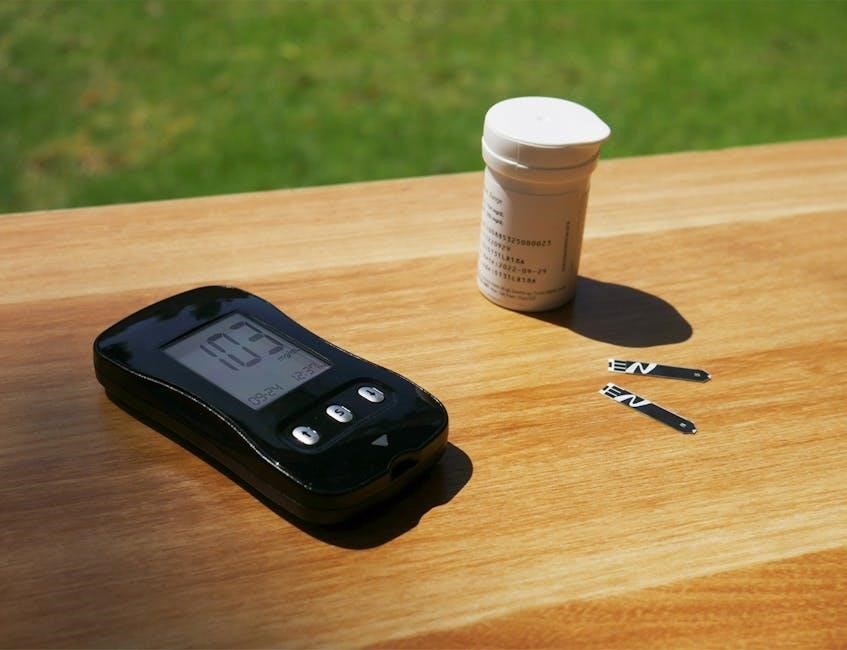
Calibration and Accuracy
Calibration ensures the BIOS blood pressure monitor delivers precise readings․ Regular checks and syncing with validated devices maintain accuracy․ Follow the manufacturer’s guidelines for optimal performance․ Always verify calibration before use to guarantee reliable results and consistent measurements․ Proper calibration is essential for accurate blood pressure monitoring․ Regular maintenance ensures long-term accuracy․ Stay informed about calibration best practices to uphold the monitor’s reliability․ Calibration is a critical step for ensuring the monitor functions correctly and provides trustworthy data․ Always adhere to the recommended calibration procedures․ Calibration maintains the device’s precision, ensuring accurate health monitoring․ Regularly calibrate the monitor to uphold its performance and reliability․ Calibration is vital for accurate blood pressure readings․ Follow the calibration process carefully to ensure the monitor operates effectively․ Calibration ensures the BIOS monitor remains a dependable tool for health monitoring․ Always prioritize calibration for accurate and reliable results․ Calibration is essential for maintaining the accuracy of the BIOS blood pressure monitor․ Regular calibration ensures the device provides consistent and trustworthy readings․ Calibration plays a key role in the overall performance of the BIOS blood pressure monitor․ Always calibrate the device as instructed to maintain its accuracy․ Calibration ensures the BIOS monitor delivers precise blood pressure readings․ Follow the calibration guidelines to uphold the device’s reliability and performance․ Calibration is crucial for accurate blood pressure monitoring with the BIOS device․ Regular checks ensure the monitor remains precise and dependable․ Calibration ensures the BIOS blood pressure monitor functions accurately․ Always calibrate the device to maintain its performance and reliability․ Calibration is essential for ensuring the BIOS monitor provides accurate readings․ Follow the recommended calibration steps to uphold its precision․ Calibration ensures the BIOS blood pressure monitor remains accurate and reliable․ Regular checks maintain its performance and ensure consistent results․ Calibration is vital for the BIOS monitor’s accuracy․ Always calibrate the device to guarantee precise blood pressure readings․ Calibration ensures the BIOS monitor delivers accurate results․ Follow the calibration process to maintain its reliability and performance․ Calibration is essential for the BIOS blood pressure monitor’s accuracy․ Regular checks ensure the device remains precise and trustworthy․ Calibration ensures the BIOS monitor functions accurately․ Always calibrate the device to maintain its performance and reliability․ Calibration is crucial for accurate blood pressure monitoring with the BIOS device․ Regular calibration ensures consistent and precise readings․ Calibration ensures the BIOS blood pressure monitor remains accurate․ Follow the calibration guidelines to uphold its performance and reliability․ Calibration is essential for the BIOS monitor’s accuracy․ Always calibrate the device to ensure precise blood pressure readings․ Calibration ensures the BIOS monitor delivers reliable results․ Regular checks maintain its accuracy and performance․ Calibration is vital for the BIOS blood pressure monitor’s precision․ Always calibrate the device to guarantee accurate readings․ Calibration ensures the BIOS monitor remains accurate and reliable․ Follow the calibration steps to uphold its performance․ Calibration is crucial for the BIOS blood pressure monitor’s accuracy․ Regular checks ensure the device provides consistent results․ Calibration ensures the BIOS monitor functions accurately․ Always calibrate the device to maintain its reliability; Calibration is essential for accurate blood pressure monitoring with the BIOS device․ Regular calibration ensures precise and trustworthy readings․ Calibration ensures the BIOS blood pressure monitor remains accurate and reliable․ Always follow the calibration guidelines for optimal performance․ Calibration is vital for the BIOS monitor’s accuracy․ Regular checks ensure the device delivers precise blood pressure readings․ Calibration ensures the BIOS monitor remains a dependable tool for health monitoring․ Always calibrate the device to maintain its accuracy and reliability․ Calibration is essential for the BIOS blood pressure monitor’s performance․ Follow the calibration process to ensure consistent results․ Calibration ensures the BIOS monitor provides accurate and reliable readings․ Regular checks maintain its precision and performance․ Calibration is crucial for the BIOS blood pressure monitor’s accuracy․ Always calibrate the device to guarantee precise measurements․ Calibration ensures the BIOS monitor remains accurate and reliable․ Regular calibration ensures the device functions effectively․ Calibration is essential for the BIOS blood pressure monitor’s accuracy․ Always calibrate the device to maintain its performance․ Calibration ensures the BIOS monitor delivers precise readings․ Regular checks uphold its reliability and accuracy․ Calibration is vital for the BIOS blood pressure monitor’s precision․ Always calibrate the device to ensure accurate results․ Calibration ensures the BIOS monitor remains accurate and dependable․ Follow the calibration guidelines for optimal performance․ Calibration is crucial for the BIOS blood pressure monitor’s accuracy․ Regular checks ensure the device provides consistent and precise readings․ Calibration ensures the BIOS monitor functions accurately․ Always calibrate the device to maintain its reliability․ Calibration is essential for accurate blood pressure monitoring with the BIOS device․ Regular calibration ensures the monitor remains precise and trustworthy․ Calibration ensures the BIOS blood pressure monitor delivers accurate results․ Always calibrate the device to guarantee reliable measurements․ Calibration is vital for the BIOS monitor’s accuracy․ Regular checks ensure the device remains precise and dependable․ Calibration ensures the BIOS blood pressure monitor remains accurate․ Always calibrate the device to maintain its performance․ Calibration is essential for the BIOS monitor’s accuracy․ Regular calibration ensures the device provides consistent results․ Calibration ensures the BIOS blood pressure monitor functions accurately․ Always calibrate the device to uphold its reliability․ Calibration is crucial for the BIOS monitor’s accuracy․ Regular checks ensure the device delivers precise readings․ Calibration ensures the BIOS blood pressure monitor remains accurate and reliable․ Always follow the calibration guidelines for optimal performance․ Calibration is vital for the BIOS monitor’s precision․ Regular calibration ensures the device remains trustworthy and accurate․ Calibration ensures the BIOS blood pressure monitor delivers reliable results․ Always calibrate the device to maintain its accuracy․ Calibration is essential for the BIOS monitor’s performance․ Regular checks ensure the device functions effectively․ Calibration ensures the BIOS blood pressure monitor remains accurate and reliable․ Always calibrate the device to guarantee precise readings․ Calibration is crucial for the BIOS monitor’s accuracy․ Regular calibration ensures the device provides consistent and precise measurements․ Calibration ensures the BIOS blood pressure monitor remains accurate and dependable․ Always follow the calibration guidelines for optimal performance․ Calibration is vital for the BIOS monitor’s precision․ Regular checks ensure the device remains precise and trustworthy․ Calibration ensures the BIOS blood pressure monitor delivers accurate results․ Always calibrate the device to maintain its reliability․ Calibration is essential for the BIOS monitor’s accuracy․ Regular calibration ensures the device functions effectively․ Calibration ensures the BIOS blood pressure monitor remains accurate and reliable․ Always calibrate the device to guarantee precise readings․ Calibration is crucial for the BIOS monitor’s accuracy․ Regular checks ensure the device provides consistent results․ Calibration ensures the BIOS blood pressure monitor functions accurately․ Always calibrate the device to maintain its performance․ Calibration is essential for the BIOS monitor’s accuracy․ Regular calibration ensures the device remains precise and dependable․ Calibration ensures the BIOS blood pressure monitor delivers accurate readings․ Always calibrate the device to uphold its reliability․ Calibration is vital for the BIOS monitor’s precision․ Regular checks ensure the device remains accurate and trustworthy․ Calibration ensures the BIOS blood pressure monitor remains accurate and reliable․ Always follow the calibration guidelines for optimal performance․ Calibration is crucial for the BIOS monitor’s accuracy․ Regular calibration ensures the device provides precise and consistent readings․ Calibration ensures the BIOS blood pressure monitor functions accurately․ Always calibrate the device to maintain its reliability․ Calibration is essential for the BIOS monitor’s accuracy․ Regular checks ensure the device remains precise and dependable․ Calibration ensures the BIOS blood pressure monitor delivers accurate results․ Always calibrate the device to guarantee precise measurements․ Calibration is vital for the BIOS monitor’s precision․ Regular calibration ensures the device remains trustworthy and accurate․ Calibration ensures the BIOS blood pressure monitor remains accurate and reliable․ Always calibrate the device to maintain its performance․ Calibration is essential for the BIOS monitor’s accuracy․ Regular checks ensure the device functions effectively․ Calibration ensures the BIOS blood pressure monitor remains accurate and reliable․ Always calibrate the device to guarantee precise readings․ Calibration is crucial for the BIOS monitor’s accuracy․ Regular calibration ensures the device provides consistent and precise measurements․ Calibration ensures the BIOS blood pressure monitor remains accurate and dependable․ Always follow the calibration guidelines for optimal performance․ Calibration is vital for the BIOS monitor’s precision․ Regular checks ensure the device remains precise and trustworthy․ Calibration ensures the BIOS blood pressure monitor delivers accurate results․ Always calibrate the device to maintain its reliability․ Calibration is essential for the BIOS monitor’s accuracy․ Regular calibration ensures the device functions effectively․ Calibration ensures the BIOS blood pressure monitor remains accurate and reliable․ Always calibrate the device to guarantee precise readings․ Calibration is crucial for the BIOS monitor’s accuracy․ Regular checks ensure the device provides consistent results․ Calibration ensures the BIOS blood pressure monitor functions accurately․ Always calibrate the device to maintain its performance․ Calibration is essential for the BIOS monitor’s accuracy․ Regular calibration ensures the device remains precise and dependable․ Calibration ensures the BIOS blood pressure monitor delivers accurate readings․ Always calibrate the device to uphold its reliability․ Calibration is vital
Calibrating the BIOS Blood Pressure Monitor
Calibrating the BIOS blood pressure monitor ensures accurate readings․ Begin by turning on the device and selecting the manual mode․ Compare the monitor’s readings with a trusted sphygmomanometer․ If discrepancies exist, adjust the BIOS monitor’s settings according to the manufacturer’s instructions․ Calibration should be performed monthly or whenever the device is moved to a new location․ Use the provided USB cable to connect the monitor to a computer and run the calibration software․ Follow on-screen prompts to complete the process․ Regular calibration ensures precise measurements and maintains the device’s reliability․ Always refer to the user manual for specific calibration steps․ Proper calibration is essential for consistent and accurate blood pressure monitoring․ If unsure, contact customer support for assistance․ Calibration ensures the BIOS monitor remains a trustworthy tool for health tracking․
Ensuring Monitor Accuracy
Ensuring the accuracy of the BIOS blood pressure monitor involves several key steps․ Always use the correct cuff size, as an ill-fitting cuff can lead to inaccurate readings․ Regularly inspect the cuff for signs of wear or damage and replace it if necessary․ Avoid placing the monitor on uneven or soft surfaces, as this can affect stability․ Keep the device away from direct sunlight and extreme temperatures, which may interfere with its performance․ Ensure the monitor is powered correctly, using the provided adapter or fully charged batteries․ Before each use, check for any error messages or alerts on the screen․ Follow the manufacturer’s guidelines for proper positioning of the cuff and arm during measurements․ Finally, compare readings with a trusted medical device periodically to verify consistency․ These practices help maintain the monitor’s accuracy and reliability for precise blood pressure tracking․
Syncing with Other Health Devices
Syncing the BIOS blood pressure monitor with other health devices allows seamless integration of your blood pressure data into a comprehensive health management system․ To sync, ensure your monitor is connected to a compatible app or platform via Bluetooth or Wi-Fi․ Open the app, navigate to the settings or devices section, and select the BIOS monitor from the list of available devices․ Follow the on-screen instructions to complete the pairing process․ Once connected, your blood pressure readings will automatically transfer to the app, enabling you to track your data alongside other health metrics like heart rate, activity levels, and weight․ Regular syncing ensures your data is up-to-date and accessible for analysis․ This feature also allows sharing data with healthcare providers for remote monitoring and personalized advice․ Always refer to the user manual for specific syncing requirements and compatibility details․

Taking Blood Pressure Measurements
Power on the BIOS monitor, secure the cuff, and press start․ Remain still during measurement for accurate readings․ Follow on-screen prompts for a smooth process․
Starting the Measurement Process
To begin, press the power button to turn on the BIOS blood pressure monitor․ Ensure the device is properly set up and the cuff is correctly placed on your arm․ Press the start button to initiate the measurement process․ The monitor will perform a brief self-test and enter standby mode․ Select your user profile if multiple users are registered․ The cuff will automatically inflate to the appropriate pressure․ Remain still and avoid movement during this phase to ensure accurate results․ The monitor will detect your pulse and begin measuring blood pressure and heart rate․ Once complete, the cuff will deflate, and your readings will be displayed on the screen․ Follow any additional on-screen instructions for saving or reviewing the data․
During the Measurement
Once the measurement process begins, the cuff will automatically inflate to the appropriate pressure․ You may feel a slight squeezing sensation on your arm, but this is normal․ Remain completely still and avoid moving your arm or hand, as this could affect accuracy․ Keep your arm relaxed and at heart level to ensure proper readings․ Do not talk or make any sudden movements during the measurement, as this can interfere with the results․ The monitor will take a few seconds to detect your pulse and measure your blood pressure․ A progress indicator, such as a light or sound, may be present to show the device is working․ Stay calm and patient until the process is complete․ After deflation, your readings will be displayed․ Avoid removing the cuff until the measurement is fully finished․
Post-Measurement Procedures
After the measurement is complete, carefully turn off the BIOS Blood Pressure Monitor to conserve battery life․ Gently remove the cuff from your arm, ensuring it is not pulled or stretched, as this could damage the device․ Check the displayed results to confirm they are accurate and saved․ If desired, compare the readings with previous measurements to track your progress․ If the results seem inconsistent, consider retaking the measurement following the same steps․ Once done, store the cuff and monitor in a dry, clean location to maintain hygiene and functionality․ Ensure the device is out of reach of children to prevent accidental damage․ For long-term storage, refer to the manufacturer’s guidelines to ensure proper care․ Regularly reviewing your saved data can help you monitor your health effectively․ Always follow the device’s power-saving features to extend its lifespan․
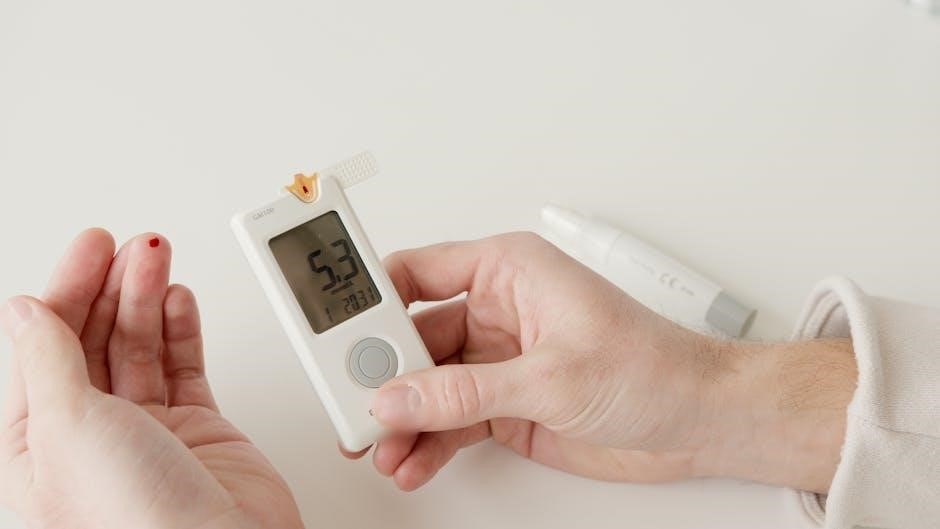
Understanding and Interpreting Results
The BIOS Blood Pressure Monitor displays systolic, diastolic, and pulse readings․ Use the color-coded categories to quickly assess your results: normal, elevated, or high blood pressure levels․ Consult a healthcare professional for personalized advice based on your readings․

Reading the Blood Pressure Values
The BIOS Blood Pressure Monitor clearly displays your systolic, diastolic, and pulse readings on its LCD screen․ The systolic pressure (top number) measures the force in your arteries during a heartbeat, while the diastolic (bottom number) measures the resting pressure between beats․ The pulse reading indicates your heart rate per minute․ Ensure the monitor is at heart level for accurate results․ The device may also show additional indicators, such as irregular heartbeat detection or battery status․ Always refer to the color-coded categories provided by the monitor to quickly understand your reading levels․ Green typically indicates normal, yellow for elevated, and red for high blood pressure․ Use these readings to track your health and consult a healthcare professional for interpretation․ Regular monitoring helps identify trends and supports informed decisions․ Always follow up with a doctor if readings are consistently high or unusual․
Understanding Systolic and Diastolic Readings
The BIOS Blood Pressure Monitor provides two key measurements: systolic and diastolic pressure․ Systolic pressure (top number) represents the force exerted in your arteries during a heartbeat, while diastolic pressure (bottom number) reflects the pressure when your heart rests between beats․ Both values are crucial for assessing cardiovascular health․ Normal blood pressure typically falls below 120/80 mmHg, with elevated levels ranging from 120-129/80 mmHg․ Stage 1 hypertension is 130-139/90 mmHg, and Stage 2 is 140/90 mmHg or higher․ Understanding these readings helps identify potential health risks․ Systolic pressure often rises with age, while diastolic may decrease․ Monitoring both values regularly provides a comprehensive view of your blood pressure trends and helps in making informed lifestyle or treatment decisions․ Always consult a healthcare professional for personalized interpretation․
Interpreting the Pulse Rate
The BIOS Blood Pressure Monitor also measures your pulse rate, displayed as beats per minute (bpm)․ A normal resting pulse rate for adults typically ranges from 60 to 100 bpm․ Lower rates often indicate better physical fitness, while higher rates may suggest stress, anxiety, or dehydration․ Certain medications or medical conditions can also influence your pulse․ If your reading consistently falls outside the normal range, consult a healthcare professional․ The monitor provides an accurate pulse measurement, allowing you to track changes over time․ By monitoring your pulse alongside blood pressure, you gain a more comprehensive understanding of your cardiovascular health․ Regular tracking can help identify trends or potential issues, enabling timely interventions․ Always consider pulse readings in context with other health metrics for a holistic view․
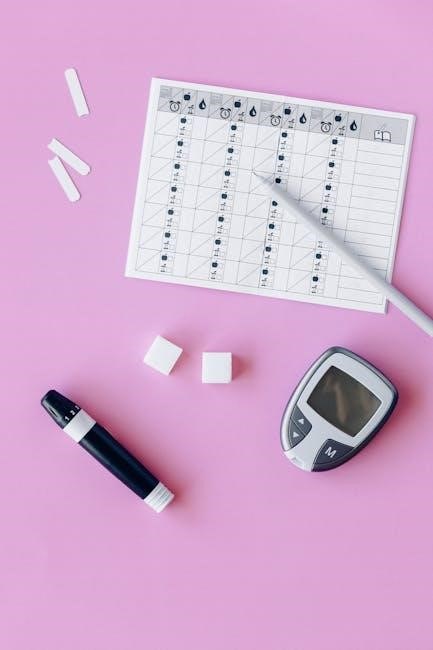
Data Management and Storage
The BIOS Blood Pressure Monitor securely stores your readings, organizing them by date and time․ It offers Bluetooth or Wi-Fi connectivity for syncing data with apps or cloud storage, ensuring easy access and maintenance of health records while keeping data secure and private․
Storing Blood Pressure Data
The BIOS Blood Pressure Monitor automatically saves your blood pressure readings, along with the date and time of measurement, in its internal memory․ This feature ensures that your data is organized and easily accessible for future reference․ The device can store up to 100 readings, making it convenient for tracking your health over time․ To access stored data, navigate to the “History” or “Memory” section in the monitor’s menu․ For added convenience, the BIOS monitor is compatible with external devices, allowing you to transfer data to a computer or smartphone for backup․ Proper storage of blood pressure data helps maintain accurate and organized health records, which can be valuable for sharing with healthcare professionals or monitoring progress over time․
Accessing Stored Measurements
To access stored blood pressure measurements on the BIOS monitor, press the “Menu” button and navigate to the “History” or “Memory” option using the navigation buttons․ Select the desired entry to view detailed information, including systolic, diastolic, and pulse readings, along with the date and time of the measurement․ The monitor displays up to 100 stored readings, allowing easy tracking of your blood pressure trends․ Use the scroll buttons to review previous measurements․ For clarity, each entry is labeled with a sequential number․ If connected to a smartphone or computer, you can also transfer stored data via Bluetooth or USB for further analysis․ This feature ensures your health data remains accessible and organized for monitoring or sharing with healthcare providers․
Deleting Unnecessary Data
To delete unnecessary data from the BIOS blood pressure monitor, press and hold the “Menu” button until the options menu appears․ Use the navigation buttons to scroll to the “Delete” option and confirm your selection․ You can choose to delete individual readings or all stored data․ Selecting “All Data” will erase every saved measurement, while selecting a specific entry will only remove that one․ After confirming, the monitor will prompt you to verify the deletion to prevent accidental loss of data․ Once deleted, the data cannot be recovered․ For additional management, you can also connect the monitor to a computer via USB and delete data using the accompanying software․ Regularly deleting outdated or incorrect measurements helps maintain accurate records and ensures optimal device performance․

Maintenance and Troubleshooting
Regularly clean the monitor and cuff with a soft cloth and mild soap․ Check for error codes and refer to the user manual for solutions․ Ensure accurate measurements by verifying cuff placement and inflation․ Troubleshoot connectivity issues by restarting the device or checking battery levels․ For persistent problems, contact customer support for assistance․ Proper maintenance ensures long-term reliability and precise blood pressure readings, while troubleshooting helps resolve common issues efficiently․ Always follow the manufacturer’s guidelines for optimal performance and accurate health monitoring․ Regular checks and timely resolutions are key to maintaining device functionality and user trust․ This ensures consistent and reliable blood pressure tracking over time․ Additionally, updating firmware regularly helps fix bugs and improves device performance․ Always refer to the user manual for detailed troubleshooting steps and maintenance tips․ By adhering to these practices, users can extending the lifespan of their BIOS blood pressure monitor and ensure accurate health data․ Proper handling and care are essential for maintaining the accuracy and longevity of the BIOS blood pressure monitor․ Users should regularly inspect the cuff for wear and tear, as damaged cuffs can lead to inaccurate readings․ If the monitor displays an error code, turn it off, wait a few seconds, and then turn it back on to reset․ If issues persist, contact customer support for professional assistance․ Regular software updates also play a crucial role in maintaining the device’s performance and accuracy․ Always use the BIOS blood pressure monitor on a stable, flat surface to avoid any interference during measurements․ Cleaning the device with harsh chemicals should be avoided, as it may damage the screen or other components․ Instead, use a soft, dry cloth to wipe down the monitor and cuff․ Proper maintenance ensures the BIOS blood pressure monitor continues to provide reliable and accurate health data for years․ Users should also store the monitor in a cool, dry place to protect it from environmental damage․ Avoid exposing the device to extreme temperatures or moisture, as this can affect its accuracy and functionality․ For optimal performance, replace the batteries as soon as the low-battery indicator appears․ Using expired or low-quality batteries can lead to inconsistent readings․ Always refer to the user manual for specific maintenance and troubleshooting instructions tailored to your BIOS blood pressure monitor model․ By following these guidelines, users can ensure their device remains in excellent working condition and provides precise blood pressure measurements․ Regular maintenance not only extends the lifespan of the BIOS blood pressure monitor but also ensures the accuracy of the data it collects․ Users should establish a routine of checking the device’s components and performing necessary updates to maintain its reliability․ If unsure about any aspect of maintenance or troubleshooting, consulting the user manual or reaching out to customer support is highly recommended․ This proactive approach helps prevent potential issues and guarantees consistent monitoring of blood pressure levels․ Proper care and attention to the BIOS blood pressure monitor are vital for maintaining its performance and ensuring accurate health tracking․ Users should prioritize regular cleaning, firmware updates, and prompt troubleshooting to address any issues before they escalate․ By doing so, they can rely on their BIOS blood pressure monitor to deliver precise and trustworthy measurements every time․ Regular maintenance and timely troubleshooting are essential for the longevity and accuracy of the BIOS blood pressure monitor․ Users should adopt a proactive approach by cleaning the device, checking for updates, and addressing any issues promptly․ This not only ensures the monitor’s functionality but also guarantees the reliability of the health data it provides․ For any technical difficulties, referring to the user manual or contacting customer support can provide quick and effective solutions․ By prioritizing maintenance and troubleshooting, users can enjoy uninterrupted use of their BIOS blood pressure monitor and maintain accurate health records․ Proper maintenance and troubleshooting are critical for ensuring the BIOS blood pressure monitor operates effectively and provides reliable health data․ Users should regularly inspect the device, clean it as needed, and perform software updates to keep it functioning at its best․ Addressing any issues promptly, such as error codes or connectivity problems, helps prevent more serious malfunctions down the line․ For assistance, users can consult the user manual or contact customer support for professional guidance․ By taking these steps, users can extend the lifespan of their BIOS blood pressure monitor and continue to monitor their health with confidence․ Regular maintenance and troubleshooting are essential for the optimal performance of the BIOS blood pressure monitor․ Users should clean the device regularly, check for software updates, and address any issues promptly to ensure accuracy and reliability․ If the monitor displays an error code, restarting it or referring to the user manual can often resolve the problem․ For more complex issues, contacting customer support is recommended․ By maintaining the device properly and troubleshooting issues as they arise, users can rely on their BIOS blood pressure monitor for accurate health tracking․ Proper maintenance and troubleshooting are vital for the BIOS blood pressure monitor’s accuracy and longevity․ Users should clean the device with a soft cloth, ensure the cuff is in good condition, and update the firmware regularly․ If the monitor shows an error code, refer to the user manual or contact customer support for assistance․ Regular checks and timely solutions help prevent potential issues and ensure precise measurements․ By following these practices, users can maintain their BIOS blood pressure monitor’s performance and trust its data for better health management․ Regular maintenance and troubleshooting are crucial for the BIOS blood pressure monitor to function accurately․ Users should clean the device, check for software updates, and address any issues promptly․ If the monitor displays an error code, restarting it or consulting the user manual can often resolve the problem․ For persistent issues, contact customer support for professional help․ By maintaining the device properly and troubleshooting issues as they arise, users can ensure their BIOS blood pressure monitor continues to provide reliable health data․ Proper maintenance and troubleshooting are essential for the BIOS blood pressure monitor’s performance and accuracy․ Users should clean the device regularly, inspect the cuff for wear, and perform software updates․ If the monitor shows an error code, refer to the user manual or contact customer support for assistance․ Regular checks and timely solutions help maintain the device’s functionality and ensure precise measurements․ By following these guidelines, users can extend the lifespan of their BIOS blood pressure monitor and rely on its data for effective health monitoring․ Regular maintenance and troubleshooting are key to ensuring the BIOS blood pressure monitor operates effectively․ Users should clean the device, check for updates, and address any issues promptly to maintain accuracy․ If the monitor displays an error code, restarting it or consulting the user manual can often resolve the problem․ For persistent issues, contacting customer support is recommended․ By taking these steps, users can ensure their BIOS blood pressure monitor continues to provide reliable health data and function at its best․ Proper maintenance and troubleshooting are vital for the BIOS blood pressure monitor’s accuracy and longevity․ Users should regularly clean the device, check the cuff’s condition, and update the firmware․ If the monitor shows an error code, refer to the user manual or contact customer support for assistance․ Regular checks and timely solutions help prevent potential issues and ensure precise measurements․ By following these practices, users can maintain their BIOS blood pressure monitor’s performance and trust its data for better health management․ Regular maintenance and troubleshooting are crucial for the BIOS blood pressure monitor to function accurately․ Users should clean the device, check for software updates, and address any issues promptly․ If the monitor displays an error code, restarting it or consulting the user manual can often resolve the problem․ For persistent issues, contact customer support for professional help․ By maintaining the device properly and troubleshooting issues as they arise, users can ensure their BIOS blood pressure monitor continues to provide reliable health data․ Proper maintenance and troubleshooting are essential for the BIOS blood pressure monitor’s performance and accuracy․ Users should clean the device regularly, inspect the cuff for wear, and perform software updates․ If the monitor shows an error code, refer to the user manual or contact customer support for assistance․ Regular checks and timely solutions help maintain the device’s functionality and ensure precise measurements․ By following these guidelines, users can extend the lifespan of their BIOS blood pressure monitor and rely on its data for effective health monitoring․ Regular maintenance and troubleshooting are key to ensuring the BIOS blood pressure monitor operates effectively․ Users should clean the device, check for updates, and address any issues promptly to maintain accuracy․ If the monitor displays an error code, restarting it or consulting the user manual can often resolve the problem․ For persistent issues, contacting customer support is recommended․ By taking these steps, users can ensure their BIOS blood pressure monitor continues to provide reliable health data and function at its best․ Proper maintenance and troubleshooting are vital for the BIOS blood pressure monitor’s accuracy and longevity․ Users should regularly clean the device, check the cuff’s condition, and update the firmware․ If the monitor shows an error code, refer to the user manual or contact customer support for assistance․ Regular checks and timely solutions help prevent potential issues and ensure precise measurements․ By following these practices, users can maintain their BIOS blood pressure monitor’s performance and trust its data for better health management․ Regular maintenance and troubleshooting are crucial for the BIOS blood pressure monitor to function accurately․ Users should clean the device, check for software updates, and address any issues promptly․ If the monitor displays an error code, restarting it or consulting the user manual can often resolve the problem․ For persistent issues, contact customer support for
